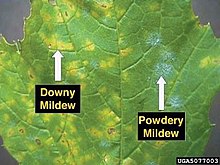
Back عفونة Arabic Míldiu Catalan Meldug Danish Mehltau German Mildiu Spanish سفیدک Persian Coincleach Irish Mildio Galician Միլնդյու Armenian Losni KW

Mildew is a form of fungus. It is distinguished from its closely related counterpart, mold, largely by its colour: molds appear in shades of black, blue, red, and green, whereas mildew is white. It appears as a thin, superficial growth consisting of minute hyphae (fungal filaments) produced especially on living plants or organic matter such as wood, paper or leather.[1][2] Both mold and mildew produce distinct offensive odours, and both have been identified as the cause of certain human ailments.
In horticulture, mildews are species of fungus in the order Erysiphales, or fungus-like organisms in the family Peronosporaceae. It is also used more generally to mean mold growth. In Old English, mildew meant honeydew (a substance secreted by aphids on leaves, formerly thought to distill from the air like dew), and later came to mean mold or fungus.[3]
- ^ "Mildew". Compact Oxford English Dictionary. Archived from the original on 8 March 2016. Retrieved 2 August 2013.
- ^ "Mildew". Merriam-Webster's Online Dictionary (11th ed.). 14 January 2024.
- ^ The American Heritage Dictionary of the English Language, 1969, entry "mecnlit-" in Appendix